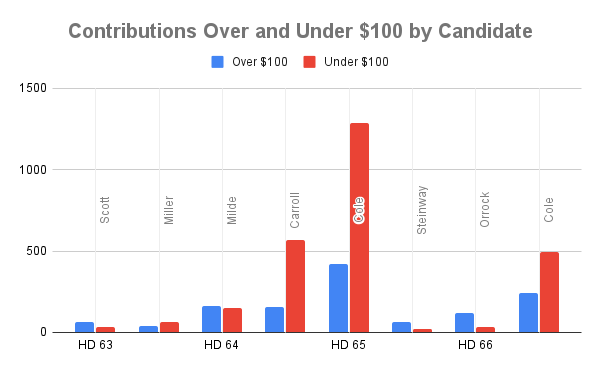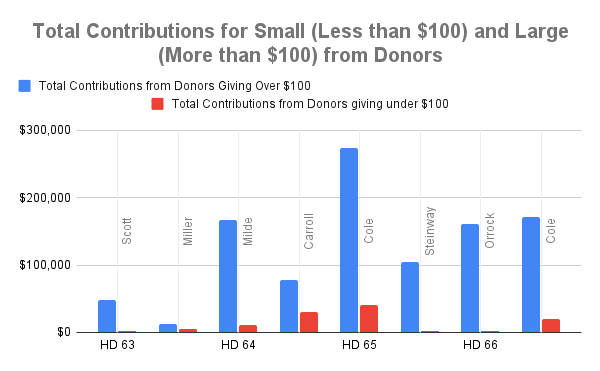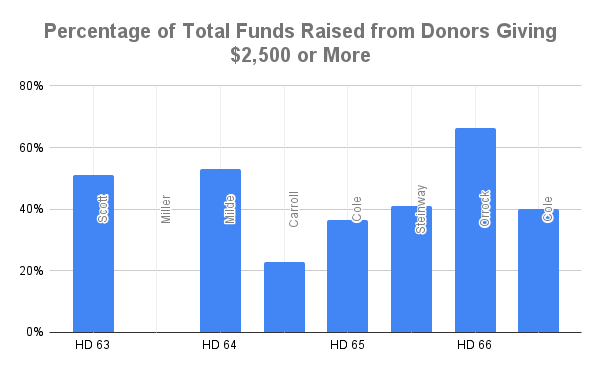ANALYSIS: Giving to Candidates Is Robust, Uneven - A Study in Five Charts
Campaign Finance reports are about as interesting to read as a budget. Numbers, numbers, numbers. A closer look, however, points to how real people are thinking about November's election.
By Martin Davis
EDITOR-IN-CHIEF
Email Martin

Labor Day traditionally kicks-off campaign season. The work of raising money, however, knows no season. The recently release campaign finance reports are a reminder of the year-round work required to finance and run a race.
These reports are more than simple records of money coming and money going. They provide tantalizing clues about how the elections to come are shaping up.
As the candidates for races in House districts 63, 64, 65, and 66 prepare to push their campaigns into overdrive this September, the money count shows can help us understand who has the advantage in early voting, for example, which begins September 19.
Contributions also provide some clues about the mindset of the electorate. How energized are local party bases? Are there signs that those trailing in the quest for dollars are showing signs of kicking into a higher gear? Or are their campaigns essentially dead-in-the-water?
In the following five (or six) charts, the Advance explores these questions and more in race for House seats this November.
Incumbency Has It Advantages
That incumbents would have an advantage in fundraising doesn’t surprise. With an established networks of donors, incumbents don’t have to build the infrastructure that new candidates seeking office have to get off the ground.
Heading into September, however, the above graphic reveals just how much of a head jump the incumbents have in this race.
In each of the four races the Advance is following, the incumbent has at least a two-to-one advantage over the challenger.
Phil Scott (HD 63) enjoys the biggest cash advantage. With $32,351 on-hand as of June 30, he has $27,866 more than his opponent, Forrest Miller.
Josh Cole (HD 65) holds the next greatest advantage. With $208,941 on-hand, he has $137,386 more than his opponent, Sean Steinway.
Paul Milde (HD 64) and Bobby Orrock (HD 66) also hold sizeable advantages over their opponents, Staci Annie Carroll (HD 64) and Nicole Cole (HD 66).
The advantage to a significant financial advantage this time of year is the boost it provides during early voting. Highly motivated voters are more likely to turn out and vote beginning September 19 than to wait for election day. Money spent now to get those voters to the polls early, and possibly sway a few opinions for those who show up and may still be sitting on the fence, can have a dramatic impact on the outcome.
So it pays to have a deep war chest in July and August. But finishing strong matters.
Contenders Holding Their Own in Fundraising
While the challengers in these races are starting behind the proverbial 8-ball in funds on-hand, most are holding their own in fundraising.
In the race for HD 63, Miller has raised a total of $32,916 — only about $17,000 less than his opponent, Scott.
Milde in HD 64 and Cole in HD 65 have greater advantages in fundraising than their opponents, but neither of their opponents — Carroll and Steinway, respectively — are being badly beaten.
The one real surprise is in HD 66, where Nicole Cole has a slight lead over Bobby Orrock in fundraising. She’s the only challenger among the four races covered in this article outraising the incumbent. Whether that advantage can hold remains to be seen, as Orrock is a well-established politician who, when necessary, can raise large amounts of money in a hurry. HD 66 will be one to watch.
So where are the dollars coming from?
Democrats Lead in Small-dollar Donations
When it comes to small-dollar donations — contributions of less than $100 — Democrats are getting the better of their Republican opponents. Each of the four Democratic candidates (Miller - 63; Carroll - 64; Josh Cole - 65; and Nicole Cole - 66) receive more donations of less than $100 than they do of gifts more than $100.
Josh Cole in HD 65 leads all candidates with 1,286 contributions from small-dollar donors. Stacie Annie Carroll in HD 64 is second with 565 contributions.
Though these small-dollar donors aren’t the greatest source of a campaign’s revenue (see below), in theory smaller-dollar donations can indicate how broad and motivated a candidate’s base of support might be.
That Democrats are showing a significant advantage over Republicans in small-dollar donors might be an early indicator that the Trump effect may be significant this year. Trump has become more-polarizing in his second term, and that fact may drive up Democratic turnout at the polls.
At the same time, Abigail Spanberger is looking like she is going to have a relatively easy run to the governor’s office. Frustration with Trump and optimism for Spanberger could significantly push up voter turnout and benefit Democrats.
Whether that’s true won’t be known until November.
While small-dollar donors are an important part of any campaign, however, large-dollar donations put more funds collectively in campaign coffers.
Bigger Dollars Driving the Election
Small-dollar donors may (or may not) indicate excitement among everyday voters on the ground, but it’s the larger financial contributions that campaigns must have to run an effective race.
Across the board, people giving large donations — defined as more than $100 — are having an out-sized influence on the amount of money candidates have to spend. Compared to big-dollar donors, the small-dollar gifts barely register as a percentage of any campaign’s coffers in the four races covered here.
The only possible exception is Forrest Miller’s campaign in HD 65, where the gap between larger and smaller donors is not as notable.
Large Donors, and LARGE DONORS
The line between large- and small-dollar donors is whether the contribution is over $100. It’s a particularly unhelpful benchmark.
There’s a small difference between a $10 gift and a $99. But in the grand scheme of a campaign that will take several hundreds of thousands of dollars to win, neither is particularly meaningful in terms of the financial impact it has.
There’s a significant difference, however, between a $150 gift and a $15,000 gift.
Of each campaign’s total dollars, how much come from people making significantly larger contributions? To better understand this, the Advance examined how many gifts over $2,500 each candidate is receiving.
As the chart below shows, three candidates — Scott, Milde, and Orrock — are most-heavily dependent upon these larger gifts when counted as a percentage of their total campaign war chest.
Having more than 50% of a campaign war chest owed to gifts of more than $2,500 can be both blessing and curse. It depends in large measure on the number of gifts of that size.
Consider that as a percentage of total contributions raised, Scott, Milde, and Orrock — all Republicans — are, for the moment, most dependent on those larger dollars. Of the three, however, Scott may be the most vulnerable.
That’s owed to the fact that Scott has received just two gifts of more than $2,500. One of those was a contribution for $21,000 that came from Dominion Energy. The second was a $5,000 gift.
In short, two grants are responsible for about 51% of his campaign dollars.
Though VPAP rates the district Strong Republican, one significant contribution for Miller can have an outsized impact on the race. A $25,000 grant pulls him even with Scott in terms of dollars he has to spend. That funding, and an electorate determined to make a statement about Trump, could potentially make this race interesting.
Milde and Orrock, by comparison, do owe substantial portions of their war chests to large contributions, but each has a broader base of big-dollar supporters. This makes it extremely difficult for their competitors to potentially close that funding gap.
The Bottom Line
As with any election, it’s important to remember that money doesn’t vote. It can, however, offer some interesting insights into what’s happening in real-time when there are no polls to help us understand how voters are feeling.
Here are three things the Advance will be watching, based on what these latest financial reports show, as we head into the fall election season.
Incumbents Have More Dollars, Contenders Are Holding Their Own - No one has opened up a dominant lead in money to this point. While the incumbents do hold the edge, the contenders are not without their supporters. There’s a lot of money to be raised between now and election day. These races are by no means a wrap.
Democrats Rising? - Donald Trump is a lightning rod. That can both help and hurt Republican candidates. If Republicans’ trouble raising small-dollar donations is, in reality, a reflection of the base’s growing dissatisfaction with Trump, this could be a tough race for the candidates wearing red.
Big Money Still Matters - While the Democrats are logging small-dollar donors, Republicans are, in general, doing a better job landing big-dollar donors (though Josh Cole and Nicole Cole are holding their own). Money doesn’t vote, but it does buy ads, and ads, we know, sway voters.
Do Small Donations Point to More Voters? — Historically, very few people contribute money to campaigns. So perhaps the commanding lead that Democrats have in attracting small-dollar donors is simply an aberration. However, it may mean an energized base that will turn out on election day.
As always — we’ll find out in November.
Support the Advance with an Annual Subscription or Make a One-time Donation
The Advance has developed a reputation for fearless journalism. Our team delivers well-researched local stories, detailed analysis of the events that are shaping our region, and a forum for robust, informed discussion about current issues.
We need your help to do this work, and there are two ways you can support this work.
Sign up for annual, renewable subscription.
Make a one-time donation of any amount.
Local Obituaries
To view local obituaries or to send a note to family and loved ones, please visit the link that follows.
This article is published under Creative Commons license CC BY-NC-ND. It can be distributed for noncommercial purposes and must include the following: “Published with permission by FXBG Advance.”


















Excellent reporting. WTG!